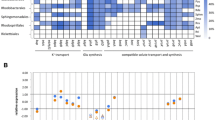Abstract
Two strains of the spoiling bacterium S. putrefaciens showed an adaptation capacity to hyperosmotic shock when they were pretreated with a sublethal concentration of NaCl. The maximal tolerance factor for the CIP 69.29 strain was obtained when cells were incubated for 1 h in the presence of 1.5% NaCl, whereas for the J13.1 strain, an incubation of 15 min in the presence of 1% NaCl seemed to be the optimal conditions to harden the cells against a subsequent lethal salt treatment. During NaCl adaptation and growth at low temperatures (2°C), 37 and 32 polypeptides were induced respectively. Interestingly, 11 proteins were common between the two different stress responses. These proteins and the corresponding genes seem to play a key role in the observed cross-protection towards the NaCl challenge induced by growth of the cultures at 2°C. One of the overlapping proteins has been identified to correspond to the alkyl hydroperoxide reductase (AhpC) of S. putrefaciens. Northern blot analysis showed that induction of this enzyme was accompanied by accumulation of the corresponding transcript under both conditions.
Similar content being viewed by others
Author information
Authors and Affiliations
Additional information
Received: 5 April 2002 / Accepted: 8 May 2002
Rights and permissions
About this article
Cite this article
Leblanc, L., Leboeuf, C., Leroi, F. et al. Comparison Between NaCl Tolerance Response and Acclimation to Cold Temperature in Shewanella putrefaciens . Curr Microbiol 46, 0157–0162 (2003). https://doi.org/10.1007/s00284-002-3837-z
Issue Date:
DOI: https://doi.org/10.1007/s00284-002-3837-z




